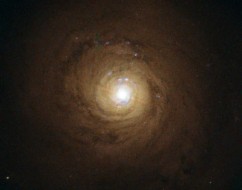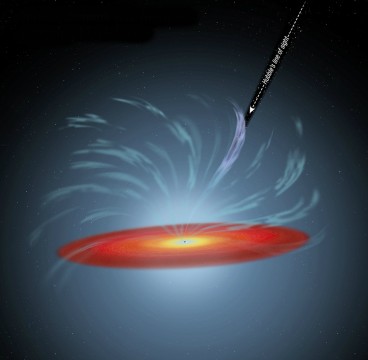Astronomers have detected a high-speed, long-lasting gas streamer spewing from the active galactic nucleus of NGC 5548. This discovery might provide new insights into how supermassive black holes influence their host galaxies.
Scientists have had their eyes on NGC 5548 for decades, but an international team of astronomers monitoring this galaxy last summer observed some unexpected behavior — namely, they discovered a new gas outflow streaming from NGC 5548's active galactic nucleus (AGN).

ESA/Hubble and NASA. Acknowledgement: Davide de Martin.
NGC 5548 is an archetypal Type-I Seyfert, which are (usually spiral) galaxies with a bright nucleus powered by a supermassive black hole rapaciously devouring matter. As they blaze with radiation, the accretion disks around the black holes that fuel AGNs can blow off powerful winds of ionized gas. Astronomers have observed many AGNs spewing out streams of gas, but NGC 5548 is the first galaxy whose gas streamer has actually moved into our line of sight, partially blocking our view of the bright core.
NGC 5548 is a lenticular galaxy 245 million light-years away that hosts a 39-million-solar-mass black hole. Previous high-resolution X-ray and ultraviolet observations showed a persistent outflow of gas from the AGN (expected for these objects), but in June 2013 astronomers observed a new, clumpy stream of ionized gas obscuring the AGN that had never been seen before. Whereas the persistent outflow starts 10 to 15 light-years from the black hole and flows outward at 1,000 kilometers per second (2 million miles per hour), the new streamer originates mere light-days from the black hole and blows five times faster.
Jelle Kaastra (Netherlands Institute for Space Research) and colleagues identified the peculiar gas streamer by combining observations from five X-ray space observatories, an ultraviolet spectrograph on the Hubble Space Telescope, and two ground-based optical telescopes. From May 2013 to September 2013 and December 2013 to February 2014, Kaastra’s team conducted an extensive multiwavelength monitoring campaign. Last June, they found that the AGN’s low-energy X-ray emission was 25 times weaker than astronomers measured in 2002. Simultaneous ultraviolet observations revealed that the persistent outflow around the AGN was also significantly cooler than when it was observed in 2011. After putting together the various observations, the team concluded that some new obscuring matter was blocking 90% of the X-ray emission.

NASA, ESA, and A. Feild (STScI)
Given the dates of the team’s observations and archival observations that the astronomers consulted, this obscuration has lasted between 2 ½ and 6 years. Because such a long-lasting outflow must be consistently replenished, the team suspects it originates near the accretion disk.
Observations of the NGC 5548 gas streamer provide the first direct evidence of a shielding process that could regulate the growth of black holes. As matter spirals into a supermassive black hole, it emits ultraviolet radiation that can induce powerful winds, which carry away gas that would have otherwise been gobbled up by the black hole. But if the gas is too saturated by X-ray radiation, then it gets “cooked” and loses its ability to absorb the ultraviolet radiation that launches it away, Kaastra explains. The new streamer in NGC 5548 shields both the more distant, persistent outflow and other gas closer to the accretion disk from the powerful X-ray radiation emitted near the black hole, allowing winds to sweep gas away from the galaxy’s core.
Although the winds billowing out from NGC 5548 are not powerful enough to significantly affect the galaxy’s evolution, the new study does improve our understanding of how this mechanism could influence galaxies that host more powerful AGNs.
Astronomers have only observed a few Seyfert galaxies with gaseous outflows like the one in NGC 5548, but luminous quasars, which host AGN powered by much more massive black holes, have been known to spew gaseous winds at several tenths the speed of light. Such powerful outflows can significantly affect the host galaxy’s evolution. Seyfert galaxies are easier to study than quasars because they are closer to us, explains Mike Eracleous (Pennsylvania State University). So by examining gaseous outflows from galaxies like NGC 5548, we might establish parallels between Seyfert galaxies and quasars that help us understand how more powerful outflows impact galactic evolution.
Reference:
J. Kaastra et al. "A fast and long-lived outflow from the supermassive black hole in NGC 5548," Science, 19 June 2014.
Dig into more mysteries of the cosmos with our special issue, Astronomy's 60 Greatest Mysteries.
 0
0
Comments
You must be logged in to post a comment.